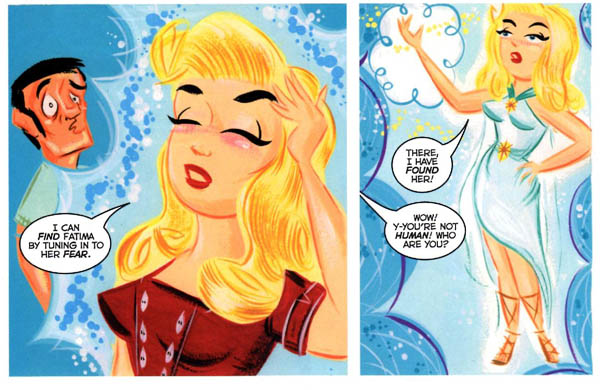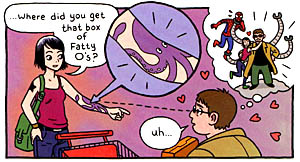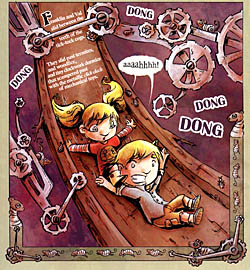 Written by Colleen Coover, G. Willow Wilson, Trina Robbins, Valerie D’Orazio, Lucy Knisley, Robin Furth, Devin Grayson
Written by Colleen Coover, G. Willow Wilson, Trina Robbins, Valerie D’Orazio, Lucy Knisley, Robin Furth, Devin Grayson
Art by Colleen Coover, Ming Doyle, Stephanie Buscema, Nikki Cook, Lucy Knisley, Agnes Garbowska, Emma Rios
48 pages, color
Published by Marvel Comics
An anthology full of creators fitting a certain demographic is hardly a new idea. We’ve had books specializing in indy comic creators, gay comics creators, and racial minority comic creators. So the idea of Girl Comics from Marvel is hardly shocking or surprising to me; while the name may be one of the less inspired (although you know exactly what you’re going to get, something that was also true with Gay Comix) I’ve generally found that anthologies of this nature for whatever reason almost always end up being slightly better than the average compilation. So for that reason alone, Girl Comics #1 was automatically going to get eyeballed by me.
Like most anthologies, there are highs and lows. Colleen Coover’s two-page introduction is certainly one of the highs; using a series of female superheroes to, line-by-line, explain why they do what they do. Of course, it’s a series of statements that equally apply to why the creators in this book work on comics, and it’s a rallying cry that ultimately crosses all genders. Coover’s art continues its cute, stripped down style that has made so many people fall in love with her comics. It doesn’t matter if she’s drawing X-Men First Class, Small Favors, or Banana Sundays, her art is always a heart-stealer.

Trina Robbins and Stephanie Buscema also provide a memorable story in a take on old comic stories where the goddess Venus worked at a fashion magazine. Shifting the action to 1969 so that she goes back to work at the magazine is fun because even in that short time period things had changed enough that poor Venus is finding herself out of date with the world around her; it’s a story that could’ve just as easily been set in modern day and had the same broad strokes, although at that point I suppose you might also have to talk about how magazines are going under left and right. It’s a funny story though, and I love Buscema’s art and how it reminds me almost of colored chalk drawings. Buscema nails the look-and-feel of the era, and she’s got a classic sensibility on how she draws her panels. It’s snazzy from start to finish.  Lucy Knisley’s Doctor Octopus two-page story is also a riot, showing what happens when the crazy Doc Ock goes to the grocery store. The panel where he sees the shopper with an octopus tattoo is worth the entire price of the comic; I love the little hearts winking into existence around his head, and his mental image of the two of them together while he throttles Spider-Man is hysterical. I fell in love with Knisley’s comics after reading her travel novel French Milk, and she continues to draw her stripped-down, adorable art here too.
Lucy Knisley’s Doctor Octopus two-page story is also a riot, showing what happens when the crazy Doc Ock goes to the grocery store. The panel where he sees the shopper with an octopus tattoo is worth the entire price of the comic; I love the little hearts winking into existence around his head, and his mental image of the two of them together while he throttles Spider-Man is hysterical. I fell in love with Knisley’s comics after reading her travel novel French Milk, and she continues to draw her stripped-down, adorable art here too.
I think the biggest surprise for me was Robin Furth and Agnes Garbowska’s story about Franklin and Valeria Richards. Furth and Garbowska play with the actual form of comics here; shifting from comic book sequential art and word balloons to a typical children’s book format of elaborate page borders, narration text laid on top of the images, and no actual panel borders as one image bleeds into the next.  As the children plunge out of the comics world into fairy tales and then later escape, it’s clever to see Garbowska add in and then throw out all of these touches. It helps of course that Garbowska’s art is great, reminding me a bit of comic creators like Ted Naifeh. If nothing else, Girl Comics #1 makes me want to see a lot more of Garbowska’s comics.
As the children plunge out of the comics world into fairy tales and then later escape, it’s clever to see Garbowska add in and then throw out all of these touches. It helps of course that Garbowska’s art is great, reminding me a bit of comic creators like Ted Naifeh. If nothing else, Girl Comics #1 makes me want to see a lot more of Garbowska’s comics.
Some stories come close but don’t quite manage, though. Valerie D’Orazio and Nikki Cook provide a fantastic page of comics about an online predator who makes the mistake of instant messaging with an undercover Punisher. That one page tells everything you need to know; what the guy looks like as he lounges around the house, where the meeting place will be, and in that final panel, the sudden shift to the Punisher typing on the other laptop as you realize just how utterly dead this creep is about to become. And then, unfortunately, there are three more pages that bring absolutely nothing extra to the story. I wish this story had stopped after the first page, because it stands on its own beautifully without three more pages that tell you everything that you’ve already figured out will happen next. And while I like Ming Doyle’s art in Girl Comics #1 as it brings an old-fashioned club and its performers to life, G. Willow Wilson’s story feels almost like an afterthought, dialogue thrown onto a series of demo pages rather than it actually building up to something. Likewise, Devin Grayson and Emma Rios provide still another take on the old Cyclops/Jean Grey/Wolverine triangle, but while it’s pretty and competently put together, I just felt like it didn’t bring anything new to the table.
All in all, though, I think Girl Comics #1 was a strong book. There are absolutely no duds in the comic; even the weakest pieces are just average, certainly not bad. Adding in biographical spotlights of prominent female creators and employees like Marie Severin and Flo Steinberg is a nice touch, giving a bit of history to the project. Hopefully people will get past any prejudices when it comics to this comic; at the end of the day it’s a solid series of comic stories where all the creators just happen to be women. I’m certainly looking forward to the remaining issues.
